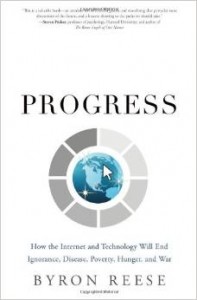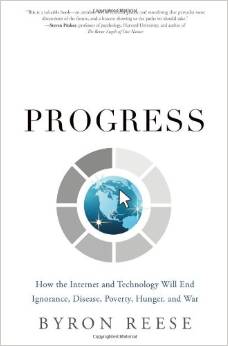A colleague referred me to Byron Reese, the author of Infinite Progress: How the Internet and Technology Will End Ignorance, Disease, Poverty, Hunger and War. Byron kindly sent me a copy of the book. Having just finished it, thought I’d share a few top-of-mind thoughts.
As you might have deduced from the title, the author is an optimist who believes technology will solve all o ur problems. When I went through the Houston Foresight program, I remember this school of thought as the positive extrapolists, for whom Julian Simon was then the poster child, so to speak. And he is briefly mentioned in Reese’s book. I would suggest that Ray Kurzweil and Singularity University are today’s leading examples of this school of though. I bring this up to note in the Houston Foresight academic program we do indeed study and explore the positive extrapolist school. And in our social change class, we look at technology as one of the key drivers of social change.
ur problems. When I went through the Houston Foresight program, I remember this school of thought as the positive extrapolists, for whom Julian Simon was then the poster child, so to speak. And he is briefly mentioned in Reese’s book. I would suggest that Ray Kurzweil and Singularity University are today’s leading examples of this school of though. I bring this up to note in the Houston Foresight academic program we do indeed study and explore the positive extrapolist school. And in our social change class, we look at technology as one of the key drivers of social change.
The title indeed indicates the chapter titles: how the Internet will end each of these “five historic plagues of human existence:” ignorance, disease, poverty, hunger, and war. In teaching our students forecasting we suggest they start with a baseline future of present trends continued – what does the future look like if present trends continue uninterrupted. Then we teach the various techniques for crafting alternative futures. We also discuss “preferred futures” – what we would like to see happen.
Infinite Progress, in my view is a bit of mix of the three. There are clearly some baseline aspects – present trends continued, with the key ones being the continuation of Moore’s Law and technological progress in general. But it’s not a true baseline in that trends not fitting the story line of tech-driven progress are not covered. Thus, it looks like an alternative future in that regard, in that it selects a set of related trends and builds a story around tech-driven progress that most would say is more positive than a true baseline. It also looks like a preferred future, in that well, most of our problems are solved. It’s sorta like all the futures wrapped into one. The critique I’d offer is to differentiate the “futures” from the future presented. In other words, we suggest that forecasting ought to include multiple future outcomes rather than just one. That said, it is fair indeed to offer a best guess about the future, it’s just unclear on what we’re getting – is it a baseline, an alternative, a preferred, or all of the above?
As for the outcomes – the ending of the five plagues – I agree that this is plausible alternative future – given an open timeframe. The key question is when. Futurist Paul Saffo, in his opening keynote at the World Future Society meeting earlier in July called for “no more forecasts without timeframes.” If, for instance, the timeframe was set at 10 or even 25 years, one might raise questions on whether the forecast is plausible within that timeframe. Could a pathway be mapped out to enable this outcome in a decade or two? If not, then it’s really a preferred future – what the author would like to see happen. There is a difference – I think we ought to let the reader know which we are talking about.
Reese also makes a strong case for optimism. I do think he’s a bit unfair in suggesting that one is either optimistic or a gloom-and-doomer. As a teacher, I try to impart the notion optimism/pessimism are interpretations, and analysis and interpretation are not the same thing. We might be looking at trends, and how the come together, and outline a forecast. We might then interpret that forecast as optimistic, pessimistic, or neither. We do not recommend doing analysis that sifts through facts to support an optimistic or pessimistic case. That said, we do use these interpretive lenses to make sure our analysis is balanced. In other words, we check our analysis to make sure we haven’t biased it one way or the other. Personally, I’ve stopped answering the question of whether I’m optimistic or pessimistic about the future – usually answering “yes” when I’m asked if optimistic or pessimistic. That said, I think it’s totally fair for one to say, as Reese has, that they are taking on or assuming an optimistic perspective – he clearly and explicitly states it.
A challenge of focusing on one future, and a very optimistic one, is that some key challenges are given short-shrift. Resource issues are addressed in one paragraph and three pages are devoted to worries or what could go wrong. As I noted above, this creates an imbalanced future. In fairness, Reese notes that more pessimistic views have been covered in other works, and that’s not what he’s doing here.
One complaint is that once again, a book about the future starts by damming all futurists while demonstrating a complete lack of knowledge about the field. Under the subhead “futurists often get it wrong” the references to futurists are:
- “In 1894, a writer…
- “In the 1930s…..social commentators….
- “A wild-eyed, crazed techno-optimist of the nineteenth century….”
Geez, that’s’ just dirty pool. The lesson here for us, as I’ve written elsewhere, is that we have to earn respect such that authors cannot get away with this sloppy treatment of our field. This is one of my motivations for participating in the APF’s exploration of the professionalization of foresight.
I believe in a “big tent” for futurists. It’s great to have different schools of thought sharing their ideas on how the future(s) might emerge. I enjoyed Reese’s book and he offers many compelling examples of how things could be better. It’s refreshing, even uplifting. I do think a stronger case could be made for this this future and thus I offer the comments above in that spirit. Andy Hines

Leave a Reply